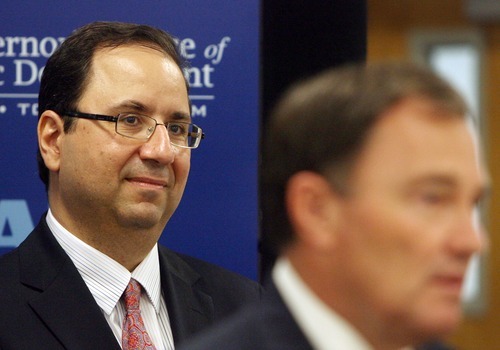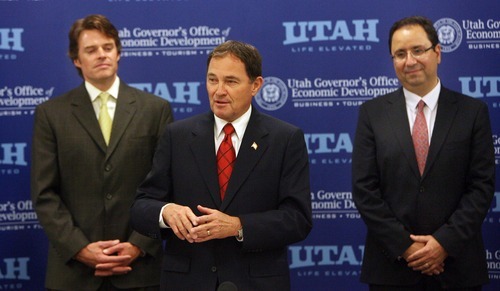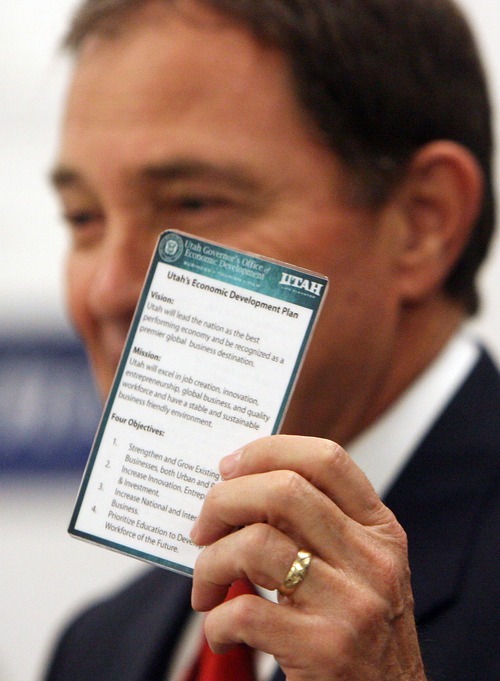This is an archived article that was published on sltrib.com in 2011, and information in the article may be outdated. It is provided only for personal research purposes and may not be reprinted.
With the help of tax incentives, one of the state's most important high-tech companies and another that is raising its profile announced Monday they will add a combined 700 high-paying jobs and invest more than a billion dollars in infrastructure over the next 10 years.
IM Flash Technologies said it would pour $1.5 billion into its flash memory chip plant in Lehi and add 200 jobs that will help ensure its presence in Utah for years to come as it faces fierce international competition.
At the same news conference in Lehi, Massachusetts-based EMC Corp. said it will be hiring about 500 tech-savvy employees for a customer-service operation in Utah to service clients worldwide of its computing hardware and software used to create and manage large banks of computers called clouds.
"Already around IM Flash, other companies that support this kind of technology are here, making it easier for the next company to move in," said Rich Brown, dean of the College of Engineering at the University of Utah. "And the state's high-tech economy is just growing."
The announcements came as the Governor's Office of Economic Development extended tax credits to the two companies to help with their expansions — $45.9 million for IM Flash and $3.5 million to EMC .
The GOED board approved the incentives at a special meeting at the sprawling IM Flash plant jointly owned by computer chipmakers Intel Corp. and Micron Technologies Inc. where about 1,500 people are employed. The credits represent one-third of new state tax revenue that will result from the investments.
EMC, which is expected to invest more than $7 million in new workspace at an undetermined location, in 2007 bought Utah-founded Mozy Inc., based in Pleasant Grove. GOED officials expect the new operation will generate $14 million in tax revenue.
If EMC locates the office in Salt Lake County, pay for the jobs it offers would represent 139 percent of the county's average wage of $41,636, while in Utah County it would be 175 percentof $34,030, according to Jerry Oldroyd, chairman of the GOED board's incentives committee.
On June 9, the GOED approved a $33.7 million tax incentive to ITT Corp., which plans to add up to 2,700 employees at a new composites manufacturing and engineering plant in the Salt Lake City area.
Utah has about 66,000 high-tech jobs, a number that besides computer-related businesses includes medical device manufacturers, telecommunications companies, medical researchers, Internet broadcasters, aerospace companies and those dedicated to engineering testing and scientific research.
The jobs announced Monday and two weeks ago are about 5 percent of that total, a significant increase.
This is "going to have a significant ripple effect throughout our economy," Gov. Gary Herbert said of the promised new jobs.
The state's official jobless rate was at 7.3 percent last month after topping 8 percent during the depths of the recession, with about 100,000 people looking for work. Utah's job growth rate of 1.5 percent is "historically very low for us," said Mark Knold, chief economist for the Utah Department of Workforce Services.
While touting the new jobs, Herbert acknowledged that "job growth is still not where we want it to be."
Keyvan Esfarjani, coexecutive officer of IM Flash, said the $1.5 billion capital investment is aimed at keeping the company ahead of international competition at a time when research quickly changes the amount of memory that can be placed on a tiny chip. That means about 10 percent of the IM Flash plant needs to be updated for the new chipsused in consumer devices such asdigital cameras and cell phones, Esfarjani said.
Micron and Intel said earlier this year they had created a technique for producing memory chips at an extremely narrow 20 nanometers, or billionths of a meter, that would be made in Lehi. The 20nm process at IM Flash manufactures the most memory in the smallest space of any flash chip memory maker.
"This investment is over a longer term," Esfarjani he said after the GOED meeting. "In fact, the tax incentive we have, the great support from the state of Utah, is spread over 10 years and it's one of those incentives in which we basically have to earn it. We bring in the revenue, we bring in the job growth and from there we essentially get a rebate."
twitter: @tharveysltrib —
Money to expand bicycle race
The Governor's Office of Economic Development board approved $100,000 for the Utah Sports Commission to help expand the Larry H. Miller Tour of Utah into an international cycling event. The board was told the event would bring major media attention to Utah with an array of top U.S. and international teams participating.









